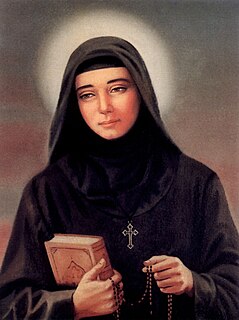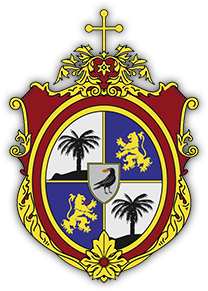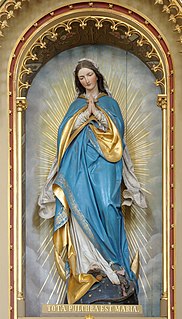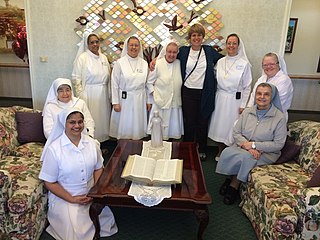
The novitiate, also called the noviciate, is the period of training and preparation that a Christian novice monastic, apostolic, or member of a religious order undergoes prior to taking vows in order to discern whether they are called to vowed religious life. It often includes times of intense study, prayer, living in community, studying the vowed life, deepening one's relationship with God, and deepening one's self-awareness. The canonical time of the novitiate is one year; in case of additional length, it must not be extended over two years. In the Eastern Orthodox Church, the novitiate is officially set at three years before one may be tonsured a monk or nun, though this requirement may be waived. The novitiate is in any case a time both for the novice to get to know the community and the community to get to know the novice. The novice should aspire to deepening their relationship to God and discovering the community's charism. The novitiate in many communities includes a concentrated program of prayer, study, reflection and limited ministerial engagement.
The novitiate, through which life in an institute is begun, is arranged so that the novices better understand their divine vocation, and indeed one which is proper to the institute, experience the manner of living of the institute, and form their mind and heart in its spirit, and so that their intention and suitability are tested.

The Sisters of St. Joseph, also known as the Congregation of the Sisters of St. Joseph and abbreviated CSJ or SSJ, is a Roman Catholic religious congregation of women founded in Le Puy-en-Velay, France, in 1650. This congregation, named for Saint Joseph, has approximately 14,000 members worldwide: about 7,000 in the United States; 2,000 in France; and are active in 50 other countries.

The Institute of Christ the King Sovereign Priest is a Roman Catholic society of apostolic life of pontifical right in communion with the Holy See of the Catholic Church. The institute has the stated goal of honoring God and the sanctification of priests in the service of the Catholic Church and souls. An integral part of the institute's charism is the use of the traditional Latin liturgy of 1962 for Mass and the other sacraments. It has undertaken the restoration of a number of historic church buildings.

Alphonsa of the Immaculate Conception or Saint Alphonsa, christened at birth as Anna Muttathupadathu, was a nun and an educator by vocation (profession). She was also known for being a victim soul, visionary and prophetess in the Kottayam pergunna of the erstwhile Travancore province of British India, in the present-day Kerala, India. She is the first woman of Indian origin to be canonised as a saint after decades of enquiry by the Sacred Congregation for the Causes of Saints, she is also the first saint of the Syro-Malabar Church, an Eastern Catholic community of Eastern Christianity.

Rafqa Pietra Chobok, O.L.M., also known as Saint Rafka and Saint Rebecca, was a Lebanese Maronite nun who was canonized by Pope John Paul II on June 10, 2001.

Miriam Teresa Demjanovich, SC was an American Ruthenian Catholic Sister of Charity who has been beatified by the Catholic Church. The beatification ceremony was the first to take place in the United States.
The Third Order of Saint Francis is a third order in the Franciscan tradition of Christianity, founded by the medieval Italian Catholic friar Francis of Assisi.

The Congregation of St. Cecilia, commonly known as the Nashville Dominicans, is a religious institute of the Roman Catholic Church located in Nashville, Tennessee. It is a member of the Council of Major Superiors of Women Religious, one of the two organizations which represent women religious in the United States. The sisters combine a monastic communal lifestyle of contemplation in the Dominican tradition with an active apostolate in Catholic education. As of 2018, the congregation has 300 sisters.
The Dominican Sisters of the Immaculate Conception are a religious community of women consecrated to Christ in the Dominican charism with the mission of living the Word of God through teaching, evangelization and health care. The community was founded in 1861 by Maria Rose Columba Bialecka (1838–1887) in Poland.

The Order of Saint Paul the First Hermit, commonly called the Pauline Fathers, is a monastic order of the Roman Catholic Church founded in Hungary during the 13th century.

Mother Mary Potter founded the sisters of the Little Company of Mary in 1877. On 8 February 1988, Pope John Paul II proclaimed her Venerable.
The Jericho Benedictines are a Society of Apostolic Life which is one of the forms of religious congregation within the Latin branch of the Catholic Church.

The Missionaries of the Company of Mary is a missionary religious congregation within the Catholic Church. The community was founded by Saint Louis de Montfort in 1705 with the recruitment of his first missionary disciple, Mathurin Rangeard. The congregation is made up of priests and brothers who serve both in the native lands and in other countries. The Montfortian Family comprises three groups: the Company of Mary, the Daughters of Wisdom and the Brothers of Saint Gabriel.

The Congregation of the Sisters of St. Paul of Chartres (SPC) is a Roman Catholic religious apostolic missionary congregation of pontifical right for teaching, nursing, visiting the poor and taking care of orphans, the old and infirm, and the mentally ill. It was founded in Levesville-la-Chenard, France in 1696.
The Little Franciscans of Mary (P.F.M.) is a Catholic congregation of women. Founded in Worcester, Massachusetts, the motherhouse is in Baie St. Paul, Quebec.

The Society of Our Lady of the Most Holy Trinity (SOLT) is a Society of Apostolic Life within the Roman Catholic Church. It was founded in 1958 by Father James H. Flanagan, a priest from the United States. The Society maintains missions in various countries, describing itself as Marian-Trinitarian, Catholic, missionary, and family. Membership in the Society includes priests, permanent deacons, religious sisters, religious brothers, and the lay faithful.

Hélène Marie Philippine de Chappotin de Neuville, known as Mary of the Passion, was a French religious sister and missionary, who founded the Franciscan Missionaries of Mary in British India in 1877, currently one of the largest religious institutes in the Catholic Church.
The Medical Missionaries of Mary are a religious institute of the Catholic Church dedicated to providing health care to the underdeveloped regions of the world. They follow a Benedictine spirituality, with its focus on life in community, shared prayer and hospitality.

The Franciscan Hospitaller Sisters of the Immaculate Conception are members of a Roman Catholic religious institute of consecrated women, which was founded in Portugal in 1871. They follow the Rule of the Third Order Regular of St. Francis. and, as the term “hospitaller” indicates, focus their ministries on a spirit of medical care. Their charism emphasizes hospitality and service under the model of the Good Samaritan. In this congregation, the postnominal initials used after each Sister's name is "F.H.I.C."
The Sisters of the Society of Saint Pius X are a semi-contemplative order of religious sisters founded by Archbishop Marcel Lefebvre on September 22, 1974. The motherhouse is located in Saint-Michel-en-Brenne, France, with additional houses in Argentina, Australia, Belgium, Germany, Italy, Switzerland and the United States. As of 2018, the current Superior General is Mother Maria Jean Bréant.















